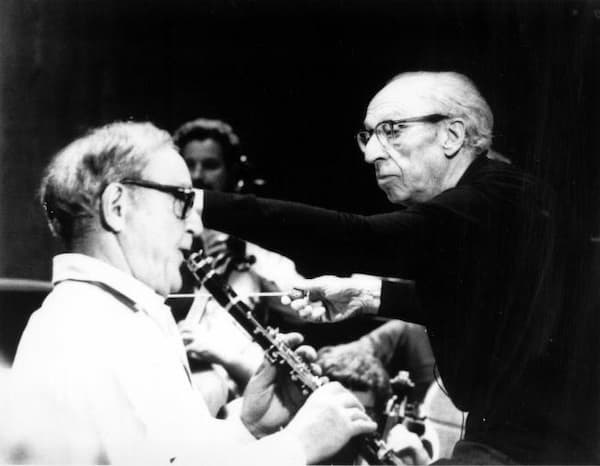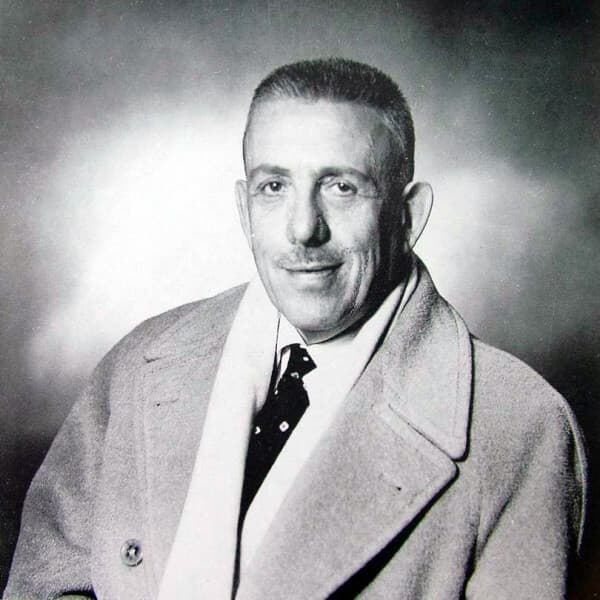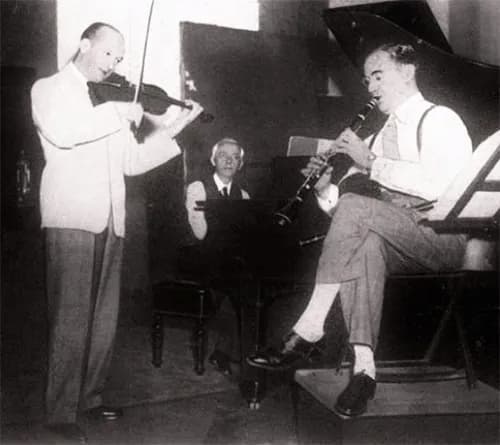Benny Goodman, born on 30 May 1909 in Chicago, is often hailed as the “King of Swing.” A clarinettist and bandleader whose innovative music and charismatic performances helped to define the Swing Era of the 1930s and 1940s.

Benny Goodman
His virtuosic clarinet playing, combined with his ability to lead dynamic ensembles, brought jazz to mainstream audiences through radio broadcasts, recordings, and legendary live performances. Goodman’s commitment to musical excellence and his groundbreaking integration of racially mixed bands made him a pivotal figure in both musical and social progress.
In addition, Goodman significantly expanded the classical clarinet repertoire by commissioning works from prominent 20th-century composers. To commemorate his birthday on 30 May, let us sample some of his most iconic commissions.
Benny Goodman Performs: “Sing, Sing, Sing”
Aaron Copland: Clarinet Concerto

Aaron Copland with Benny Goodman
In 1947, Benny Goodman took a bold step beyond the jazz world by commissioning a clarinet concerto from Aaron Copland. Goodman, whose virtuosic clarinet playing had already bridged jazz and classical realms, sought a work that would showcase his technical prowess while expanding his artistic legacy.
The commission reflected Goodman’s ambition to elevate the clarinet’s place in classical music and his desire to collaborate with a composer whose modernist sensibilities could complement his own improvisational flair.
The Clarinet Concerto is a testament to the synergy between Goodman’s vision and Copland’s genius. The piece unfolds in two contrasting movements connected by a dazzling cadenza, all tailored to Goodman’s agile technique and warm tone. The concerto remains a cornerstone in the clarinet repertoire.
Benny Goodman Performs Copland: Clarinet Concerto (excerpt)
Paul Hindemith: Clarinet Concerto

Paul Hindemith with Benny Goodman
Benny Goodman also commissioned a clarinet concerto from Paul Hindemith in 1947. Empowered by his success in the jazz world, Goodman sought to solidify his presence in the classical sphere, leveraging his technical brilliance and musical curiosity to collaborate with one of the 20th century’s most formidable composers.
Hindemith composed a concerto that balanced neoclassical precision with playful and lyrical warmth. A vibrant dialogue between soloist and ensemble, the concerto reflected Hindemith’s structural genius and Goodman’s expressive range.
The premiere was a triumph of technical and artistic synergy, highlighting Goodman’s ability to navigate Hindemith’s intricate score while infusing it with his signature warmth. The Hindemith Clarinet Concerto remains a testament to their shared commitment to pushing musical boundaries, a bold fusion of classical rigour and jazz-inflected vitality that continues to captivate listeners.
Paul Hindemith: Clarinet Concerto (Martin Fröst, clarinet; Malmö Symphony Orchestra; Lan Shui, cond.)
Francis Poulenc: Clarinet Sonata

Francis Poulenc
Benny Goodman commissioned Francis Poulenc to compose a Clarinet Sonata in 1962. Sadly, Poulenc died of a heart attack in Paris just a few months before the world premiere, which took place on 10 April 1963 at Carnegie Hall with Goodman and Leonard Bernstein as the pianist. The sonata became an immediate hit around the world, beloved for its enchanting vocal melodies, sparkling harmonies, and dazzling virtuoso passagework.
The opening is dramatic, self-consciously overwrought, and sassy, with its own internal slow elegy. The “Romanza” is a gentle lament, marked très calme, and the concluding “Allegro con fuoco” is bright and brittle. What a fun and exciting piece, and some composers and performers actually considered it the finest sonata for clarinet written in the modern era.
Francis Poulenc: Clarinet Sonata
Béla Bartók: Contrasts

Joseph Szigeti, Béla Bartók with Benny Goodman
In 1938, Benny Goodman joined forces with Hungarian violinist Joseph Szigeti to commission a groundbreaking chamber work from composer Béla Bartók. Goodman saw the collaboration as an opportunity to showcase his virtuosity in a classical context, and the commission called for a piece that would highlight the distinct timbres of clarinet and violin.
The result was a three-movement work that fused Bartók’s angular, Eastern European folk influences with a nod to Goodman’s rhythmic flair. Contrasts is a dazzling display of Bartók’s compositional genius and Goodman’s versatility, blending fiery virtuosity with haunting lyricism.
Contrasts remains a cornerstone of the chamber music repertoire, a testament to Goodman’s fearless exploration of new musical worlds and his pivotal role in bringing Bartók’s visionary score to life.
Benny Goodman’s artistry, a seamless blend of technical brilliance, jazz vitality, and classical finesse, forever transformed the clarinet’s role in music. Goodman left an indelible legacy as the “King of Swing” and a fearless innovator.
For more of the best in classical music, sign up for our E-Newsletter
Béla Bartók: Contrasts (Benny Goodman, clarinet; Joseph Szigeti, violin; Béla Bartók, piano)
